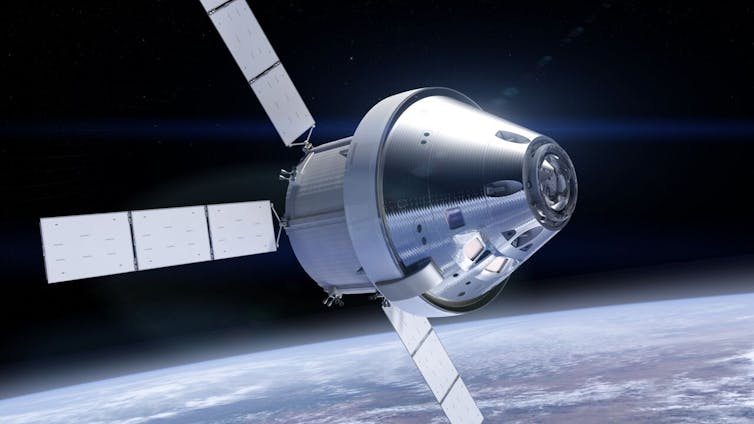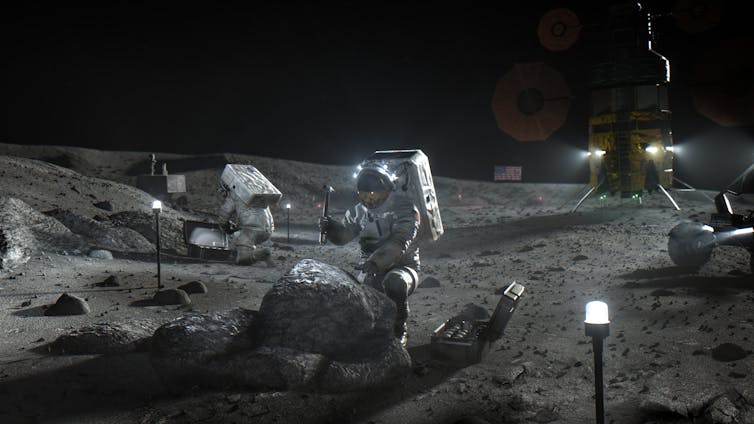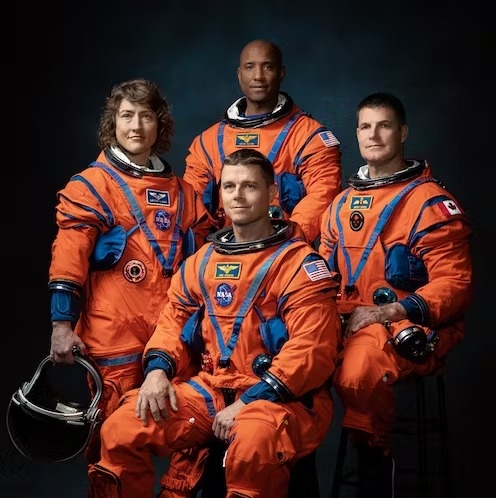If all goes to plan, sometime in November 2024, NASA’s newly announced Artemis II crew – Christina Koch, Victor Glover, Reid Wiseman and Canadian astronaut Jeremy Hansen – will cram themselves into their Orion space capsule and begin their final checks for launch.
As they sit perched atop the gargantuan Space Launch System (SLS) rocket at Kennedy Space Center in Florida, waiting for the inferno beneath them to light, the world will hold its breath.
Should they survive the violence of that ignition and the journey into Earth orbit, an adventure the likes of which we haven’t seen in more than half a century will await them.
The booster stage aboard their ship of exploration will rip them from Earth’s immediate vicinity and inject them onto a trajectory that will carry them to the Moon, hurtling into the void at more than 25,000mph. They will be travelling faster and further than any human since the Apollo 17 mission in 1972.
NASA has drawn from a deep well of past experience and technologies for this mission; employing the same main engines and solid rocket booster technology that powered the space shuttle.
The space agency has made many improvements, learning the hard-won lessons of past catastrophe. SLS and Orion represent evolution rather than revolution. Nevertheless, there will be nothing routine about this flight.

Artemis astronauts will travel in the Orion spacecraft. NASA
Risk is everywhere
We know in theory how safe we expect Artemis II to be – all of those probabilities have been calculated carefully. But there is all too often a gulf between expectation and reality.
Life for astronauts aboard the International Space Station is already replete with risk. But for the Artemis II crew there will be additional dangers. In the face of an emergency, space station crews orbiting at an altitude of around 250 miles can usually return to Earth in a matter of hours.
Rescue from deep space, possibly hundreds of thousands of miles away from Earth, is a different prospect – as the crew of Apollo 13 famously demonstrated in 1970.
Radiation is also a substantial hazard. Astronauts operating in low-Earth orbit benefit from Earth’s dense magnetic field, or magnetosphere, which shields them from harmful solar and cosmic radiation. For lunar missions, crews will venture beyond the protection of the magnetosphere, and will be more vulnerable to radiation exposure.
Solar flares in particular, which see short-lived but intense outpourings of highly energetic, charged particles, represent a powerful potential threat. If such an event should occur while Orion is coasting between the Earth and Moon, Artemis astronauts will enter a well-protected area at the base of the spacecraft, and wait there until the solar storm abates.
A new confidence
Despite all this, confidence is high*ok?*. Apollo crews faced the same risks when space engineering and technology were in their infancy – in capsules that featured no comparable shelter against radiation.
We know from those audacious missions that the “new ocean of space” –- as President John F Kennedy once called it –- can be sailed successfully and safely. There is every expectation that one day soon the Artemis II crew might do the same.
Artemis II is a pathfinder mission, set to orbit the Moon without landing. It will pave the way for subsequent expeditions, including the first return to the lunar surface since the 1970s, Artemis III, which is slated for 2025. No one knows if these timelines can be adhered to. This is rocket science and the sheer complexity of the endeavour means that schedules can slip.

Artemis astronauts will eventually explore the surface. NASA
But what will follow is a comprehensive exploration of the lunar surface by astronaut crews, including a survey of the water ice that’s apparently present in its polar regions. The intent is to do more than get in and out, leaving flags and footprints.
Artemis is about persisting in this environment, in an effort to establish a firmer foothold in the frontier of space. The lunar water ice is a potentially important resource in that regard: it could provide drinking water and –- by separating out the hydrogen and oxygen contained in water molecules – the chemical ingredients for rocket propellant.
Artemis II must come first. Despite exhaustive planning, this mission will be something of a leap of faith. After the astronauts leave Earth, all who truly understand the scale of the challenge this crew faces will wait with bated breath until they splash down safely in the Atlantic Ocean. Human spaceflight has always been this way.
Reflecting change
When Jim Lovell, Bill Anders and Frank Borman embarked upon their historic journey to become the first humans to orbit the Moon in 1968, aboard Apollo 8, they left a world ravaged by war, a country facing civil unrest and the shadow of the political assassinations of Reverend Martin Luther King and Senator Robert Kennedy. The world has changed a great deal since then – how much it has improved is a matter for historians to debate.
Artemis II represents a feat of exploration and progress in scientific endeavour, and much more besides. Glover will be the first non-white astronaut, Hansen the first non-American and Koch the first female astronaut to depart low-Earth orbit and travel to the Moon. This of course is merely one small step, but the composition of the crew is testament to NASA’s commitment to diversity in this new era.
This aspect is every bit as important as the technical detail. When it comes to journeys into the unknown, NASA has often led the way, showing us what we might be at our best, demonstrating that there might be a place in the future for all of us.
When the crew of Artemis II arrives in lunar orbit, filming the magnificent desolation of the moonscape below, the world will watch in wonder. Those moments will undoubtedly fire the ambitions of a new generation of explorers and scientists, who will see themselves properly reflected in this diverse crew. In that alone, there is something deeply hopeful.



 Six space missions to look forward to in 2024
Six space missions to look forward to in 2024  If life exists on Jupiter’s moon Europa, scientists might soon be able to detect it
If life exists on Jupiter’s moon Europa, scientists might soon be able to detect it  A Nasa rover has reached a promising place to search for fossilised life on Mars
A Nasa rover has reached a promising place to search for fossilised life on Mars  How do airplanes fly? An aerospace engineer explains the physics of flight
How do airplanes fly? An aerospace engineer explains the physics of flight  Synthetic human embryos let researchers study early development while sidestepping ethical and logistical hurdles
Synthetic human embryos let researchers study early development while sidestepping ethical and logistical hurdles  Larger and more frequent solar storms will make for potential disruptions and spectacular auroras on Earth
Larger and more frequent solar storms will make for potential disruptions and spectacular auroras on Earth  Our survey of the sky is uncovering the secrets of how planets are born
Our survey of the sky is uncovering the secrets of how planets are born  The rising flood of space junk is a risk to us on Earth – and governments are on the hook
The rising flood of space junk is a risk to us on Earth – and governments are on the hook  Why some people don't trust science – and how to change their minds
Why some people don't trust science – and how to change their minds  What is minoxidil, the anti-balding hair growth treatment? Here’s what the science says
What is minoxidil, the anti-balding hair growth treatment? Here’s what the science says  Orbital resonance − the striking gravitational dance done by planets with aligning orbits
Orbital resonance − the striking gravitational dance done by planets with aligning orbits  Black hole, neutron star or something new? We discovered an object that defies explanation
Black hole, neutron star or something new? We discovered an object that defies explanation  IceCube researchers detect a rare type of energetic neutrino sent from powerful astronomical objects
IceCube researchers detect a rare type of energetic neutrino sent from powerful astronomical objects  The brightest object in the universe is a black hole that eats a star a day
The brightest object in the universe is a black hole that eats a star a day  Why is the universe ripping itself apart? A new study of exploding stars shows dark energy may be more complicated than we thought
Why is the universe ripping itself apart? A new study of exploding stars shows dark energy may be more complicated than we thought 
































